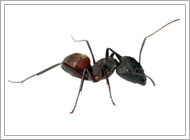Leafcutter Ant

Leafcutter ants are social insects found in warmer regions of the Americas. These unique ants have evolved an advanced agricultural system based on ant-fungus mutualism. They feed on special structures called gongylidia produced by a specialized fungus that grows only in the underground chambers of the ants' nest.
Different species of leafcutter ants use different species of fungus, but all of the fungi the ants use are members of the Lepiotaceae family. The ants actively cultivate their fungus, feeding it with freshly-cut plant material and maintaining it free from pests and molds. This mutualist relationship is further augmented by another symbiotic partner, a bacterium that grows on the ants and secretes chemicals- essentially the ants use portable antimicrobials. Leaf cutter ants are sensitive enough to adapt to the fungi's reaction to different plant material, apparently detecting chemical signals from the fungus. If a particular type of leaf is toxic to the fungus the colony will no longer collect it.
The only two other groups of insects that have evolved fungus-based agriculture are ambrosia beetles and termites.
Leafcutter ants comprise two genera — Atta and Acromyrmex — with a total of 41 species (15 in Atta and 26 in Acromyrmex), some of which are major agricultural pests.
The Acromyrmex and Atta ants have much in common anatomically; however, the two can be identified by their external differences. Atta ants have 3 pairs of spines and a smooth exoskeleton on the upper surface of the thorax while Acromyrmex have 4 pairs and a rough exoskeleton. A mature leafcutter colony can contain more than 8 million ants, mostly sterile female workers. They are divided into castes, based mostly on size, that perform different functions. Acromyrmex and Atta exhibit a high degree of biological polymorphism, four castes being present in established colonies - minims, minors, mediae and majors. Majors are also known as soldiers or dinergates. Atta ants are more polymorphic than Acromyrmex, meaning that there is comparatively less difference in size from the smallest to largest types of Acromymex.
All of the above information came from Wikipedia, the free encyclopedia

